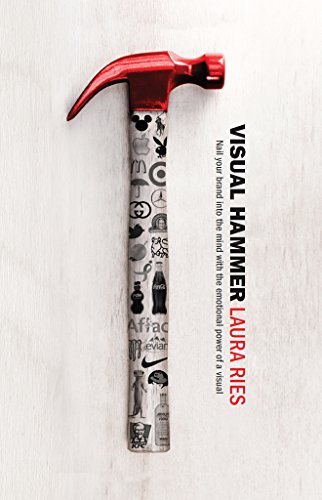When my dad, Al Ries, wrote “Positioning: The Battle for Your Mind” in 1981, he overlooked one important idea. The visual.
Positioning is a totally verbal concept. You build a brand by owning a word in the mind.
Yet the best way into a mind is not with words at all. The best way into a mind is with visuals.
But not any visual. You need a “visual hammer” that hammers a verbal nail. The Marlboro cowboy. Coca-Cola’s contour bottle. Corona’s lime.
The cowboy hammers “masculinity.” The contour bottle hammers “authenticity.” The lime hammers “genuine Mexican beer.”
A trademark is not a visual hammer. Almost every brand has a trademark, but fewer than one out of a hundred brands have a visual hammer. A trademark is a rebus which communicates nothing except the name of the brand.
A visual hammer, on the other hand, communicates the essence of the brand.
Visual Hammer is the first book to document the superiority of the “hammer and nail” approach to branding. Some examples.
The pink ribbon that made Susan G. Komen for the Cure the largest nonprofit foundation to fight breast cancer.
The Aflac duck that increased Aflac’s name recognition from 12 percent to 94 percent.
The green jacket which made the Masters the most-prestigious golf tournament.
The polo player which made Ralph Lauren the largest-selling high-end clothing brand.
The bottle which made Absolut the largest-selling high-end vodka.
The watchband which made Rolex the largest-selling luxury watch.
The red soles which made Christian Louboutin the leading luxury-shoe brand.
The chalice which made Stella Artois the fifth largest-selling imported beer.
Colonel Sanders who made KFC the world’s largest chicken chain.
Why are marketing plans usually nothing but words when the best way into a mind is with the emotional power of a visual?
After reading Visual Hammer, you might want to tear up your current marketing plan and start fresh.
چکیده فارسی
زمانی که پدرم، آل ریس، در سال 1981، "موقعیت یابی: نبرد برای ذهن شما" را نوشت، یک ایده مهم را نادیده گرفت. تصویری.
موقعیت یابی یک مفهوم کاملاً کلامی است. شما با داشتن یک کلمه در ذهن، یک برند می سازید.
با این حال بهترین راه برای ورود به ذهن اصلاً با کلمات نیست. بهترین راه برای رسیدن به ذهن، تصاویر بصری است.
اما نه هیچ تصویری. شما به یک "چکش بصری" نیاز دارید که یک میخ کلامی را بکوبد. کابوی مارلبرو. بطری کانتور کوکاکولا. آهک کرونا.
کابوی "مردانگی" را چکش می کند. بطری کانتور "اصالت" را نشان می دهد. چکش آهک "آبجوی مکزیکی اصیل".
یک علامت تجاری یک چکش بصری نیست. تقریباً هر برند دارای یک علامت تجاری است، اما کمتر از یک برند از هر صد برند دارای چکش بصری هستند. یک علامت تجاری یک rebus است که چیزی جز نام برند را با هم ارتباط نمی دهد.
از سوی دیگر، یک چکش بصری ماهیت نام تجاری را بیان می کند.
چکش بصری اولین کتابی است که برتری رویکرد "چکش و میخ" در برندسازی را مستند می کند. چند نمونه.
روبان صورتی که سوزان جی کومن برای درمان را به بزرگترین بنیاد غیرانتفاعی برای مبارزه با سرطان سینه تبدیل کرد.
اردک Aflac که تشخیص نام Aflac را از 12 درصد به 94 درصد افزایش داد.
ژاکت سبزی که Masters را به معتبرترین مسابقات گلف تبدیل کرد.
بازیکن چوگان که رالف لورن را به پرفروشترین برند لباسهای سطح بالا تبدیل کرد.
بطری که Absolut را به پرفروشترین ودکای گرانقیمت تبدیل کرد.
بند ساعتی که Rolex را به پرفروشترین ساعت لوکس تبدیل کرد.
کفهای قرمز که کریستین لوبوتین را به برند برتر کفشهای لوکس تبدیل کرد.
جامی که استلا آرتوآ را به پنجمین پرفروش ترین آبجو وارداتی تبدیل کرد.
سرهنگ سندرز که KFC را به بزرگترین زنجیره مرغ در جهان تبدیل کرد.
چرا برنامههای بازاریابی معمولاً چیزی جز کلمات نیستند، در حالی که بهترین راه برای ورود به ذهن با قدرت احساسی یک تصویر است؟
پس از خواندن Visual Hammer، ممکن است بخواهید برنامه بازاریابی فعلی خود را پاره کنید و تازه شروع کنید.
ادامه ...
بستن ...










